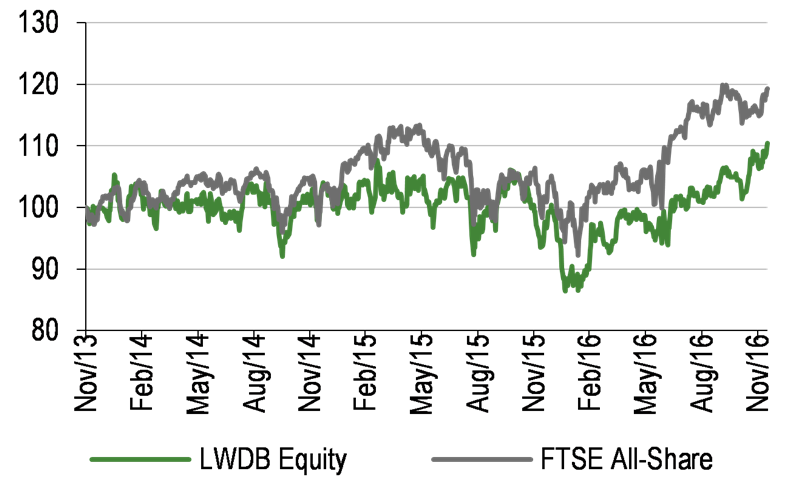The fund managers: James Henderson and Laura Foll
The managers’ view: Taking a cautious approach
James Henderson observes that large swings in sentiment were seen in H116, with value coming back into favour from February to April, which suited the positioning of the portfolio, while in May there was a shift back towards defensive stocks and those with earnings momentum. These moves were seen as a reaction to uncertainty relating to the EU referendum and the timing of US interest rate hikes. During the half-year, the manager continued with the strategy of gradually shifting the portfolio towards better value areas of the market.
Henderson’s view is that a long, diversified list of holdings was the best form of downside protection ahead of the UK’s EU referendum and remains so after the vote. LWDB benefited in June from its holdings in overseas funds, including Stewart Asia Pacific Leaders and Templeton Emerging Markets, as well as direct overseas holdings such as Lockheed Martin. However, LWDB’s relatively high exposure to small and mid-cap UK companies, which suffered disproportionate share price falls after the Brexit vote as sterling devalued, weighed on the trust’s performance relative to the majority of its global sector peers.
Henderson notes that, relative to its FTSE All-Share index benchmark, LWDB’s performance was held back by its low weighting in consumer staples stocks, which performed well due to their safe haven status and overseas earnings exposure. He highlights that stocks exposed to UK construction, such as Marshalls and Ibstock, were the biggest detractors from performance in June 2016, with a slowdown in the pace of housing construction expected to result from a period of economic uncertainty following the Brexit vote. There was no common theme seen across the portfolio’s five weakest performing holdings during H116, which were Interserve, IP Group, International Consolidated Airlines, Provident Financial and Marshalls, and the manager believes that these all remain good businesses whose share prices should recover.
During June 2016, the manager reduced the portfolio’s two largest open-ended fund holdings, Henderson Asia Pacific Capital Growth and Henderson Japan Opportunities, selling out of both funds in July. The proceeds were largely allocated to two closed-ended funds, Scottish Oriental Smaller Companies Trust and Schroder Japan Growth, both of which were trading at double-digit discounts to NAV and were seen as offering better value exposure to these regions.
During H116, positions were initiated in Vodafone, Barclays and Watkin Jones in the UK, Irish Continental Group in Ireland, Publicis and Elis in France, SAP in Germany and Microchip Technology in the US. The manager increased positions in HSBC and Standard Chartered in H116, while adding to holdings in Caterpillar, Rolls-Royce and Irish Continental Group since the end of June. Holdings in house builders Redrow and Bellway were sold during H116 and LWDB has recently sold its holdings in Glencore and Anglo American, which were among the portfolio’s top five performers during the half-year, alongside Royal Dutch Shell, Weir and BP. Since the end of June, the trust’s holdings in Tullow Oil and Greencore have also been sold.
After the initial negative reaction to the Brexit vote, the UK equity market performed well, with the FTSE All-Share index returning 7.8% and the FTSE 250 index delivering 10.7% in the three months to end-September 2016. Against this background, LWDB achieved a 9.4% NAV total return for the quarter, with falling UK gilt yields increasing the fair value of its debt, which detracted from performance. Among the top contributors to performance for the quarter were industrials stocks including Hill & Smith, Morgan Advanced Materials, Rolls-Royce, Balfour Beatty and Weir Group. International holdings Applied Materials and Microsoft also performed well, while Brazilian jet manufacturer Embraer was one of the largest detractors.
In view of the elevated economic uncertainty following the Brexit vote, the manager has been taking a cautious approach and LWDB’s market exposure has been reduced, with net gearing falling from 12.0% at end-June 2016 to 7.0% at end-July. The manager indicates that LWDB remains a net seller of investments and does not rule out the trust moving to a net cash position, although net gearing has remained broadly stable since July, standing at 8.0% at end-November.


























